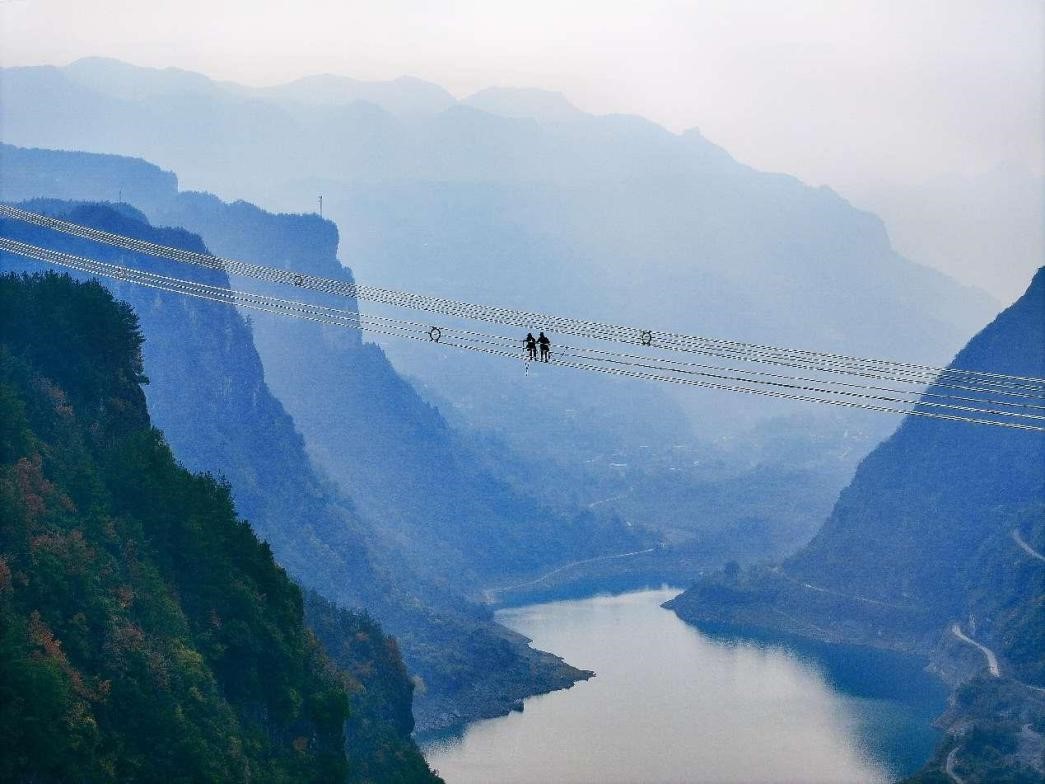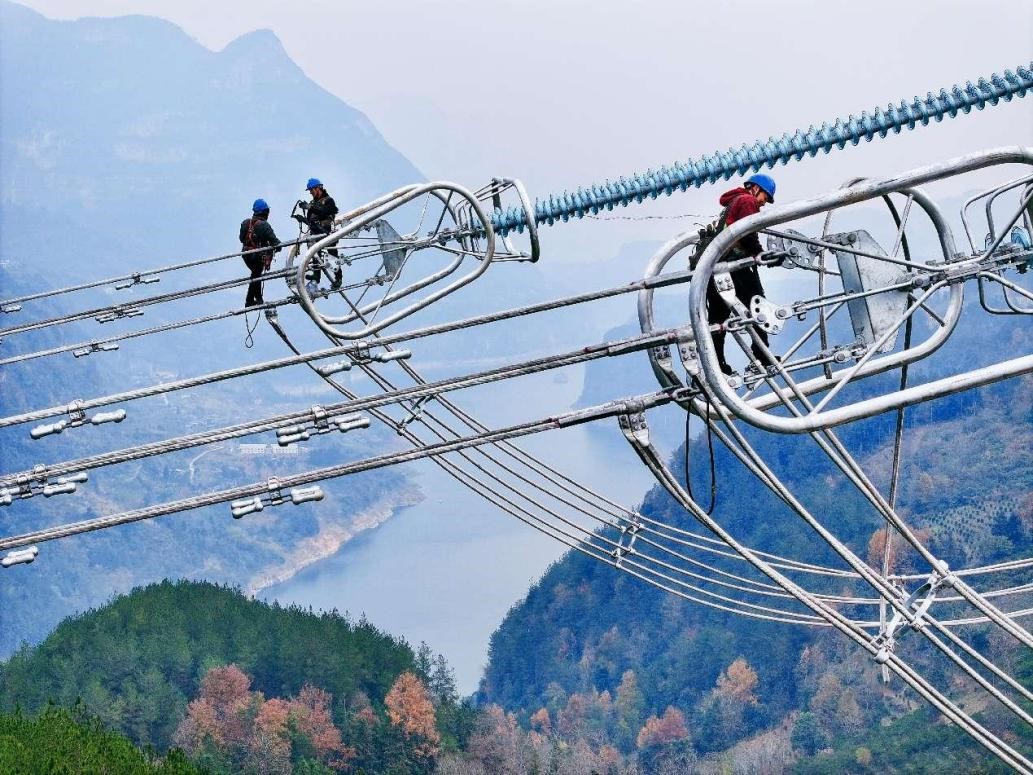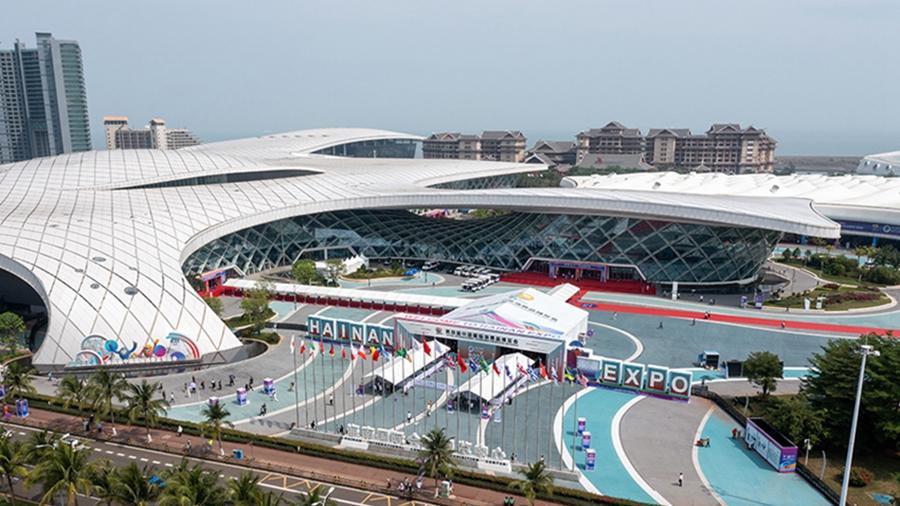China builds world's highest UHVDC transmission project
Celebrated as one of China's "power highways," the ±800 kV ultra-high-voltage direct current (UHVDC) transmission project from the upper reaches of the Jinsha River to central China's Hubei province is the highest UHVDC transmission project in the world.
With a total length of 1,901 kilometers, the transmission project passes through northwest China's Xizang autonomous region, southwest China's Sichuan province, southwest China's Chongqing municipality, and Hubei.
Upon completion, it will transmit hydropower, wind power, and solar power from the upper reaches of the Jinsha River to China's central regions, delivering approximately 40 billion kWh of clean energy annually. It is expected to reduce coal consumption by over 17 million tons and cut carbon dioxide emissions by around 34 million tons.

Photo shows the construction of the ±800 kV ultra-high-voltage direct current (UHVDC) transmission project in Wuyaba village, Hongtu township, Enshi, central China's Hubei province, Dec. 19, 2024. (Photo by Zhang Yuanming/People's Daily Online)
An altitude of 4797.9 meters
In October 2024, the construction of power transmission towers for the project was completed in Batang county, Ganzi Tibet autonomous prefecture, Sichuan province. The towers, standing 65 meters tall and weighing 85 tons, were located on the snow-covered Setongma mountain in the county, breaking the world's record for UHVDC construction with an altitude of 4797.9 meters.
"This is the highest section of the entire project, with the altitude ranging from 3,700 meters to 4,800 meters. Some parts were even covered with ice that could be as thick as 60 millimeters. The harsh natural environment not only makes our workers prone to oxygen shortages, but also affects the performance of some machinery," said Shi Mingqing, project manager of Section 4.
Shi said that to facilitate the construction, they adopted a specialized high-altitude machinery. Portable oxygen and medications were also available on site.
Overcoming challenges in harsh natural environment
As the first UHVDC project reaching the hinterland of the Qinghai-Xizang Plateau, reputed as the "roof of the world," the project has overcome multiple challenges.
The first major challenge lies in transportation. For example, Section 10 of the project in Sichuan province involved the construction of 113 towers on a mountain ridge with a maximum slope of 65 degrees. One of the primary difficulties for the construction team was to transport nearly 75,000 tons of materials necessary for tower construction into the deep mountains and up to the ridge.
To address the challenge, the construction team built six roads with a total length of 36 kilometers, said Zou Zhongxuan, project manager of Section 10. Besides, to protect the ecological environment, they adopted cable transportation at every location and built 82 cableways spanning over 60 kilometers, except for the areas that required temporary roads.
"The route from Luding county in Sichuan province to the construction site has over 100 S-shaped or U-shaped bends. Each cableway can carry less than 5 tons of tower materials on average every day. It would take a month to transport the materials for building a 143-ton tower under ideal conditions, not to mention our heaviest tower weighing nearly 400 tons," Zou said.
Another major challenge is the risks brought about by the complex geographical environment. In the Chongqing section, mountainous terrain accounts for over 60 percent, with a total of nine crossings over high-speed railways and expressways, six over navigable rivers, and 30 over important power lines. In Hubei, the power transmission towers pass through the Yangtze River twice, with 60 percent of tower bases threading through the karst landform in the Enshi section.
The construction team has been strengthening independent innovation, making continuous breakthroughs in high-voltage transmission technologies, upgrading equipment, and enhancing construction capabilities, all in an effort to tackle the challenges.

Photo shows the construction of the ±800 kV ultra-high-voltage direct current (UHVDC) transmission project in Wuyaba village, Hongtu township, Enshi, central China's Hubei province, Dec. 19, 2024. (Photo by Zhang Yuanming/People's Daily Online)
Intelligent tension-stringing system
At a construction site in Yingjing county, Ya'an city of Sichuan, a steel wire rope was connected with a traction walking plate to lift two wires into the air, each with a diameter of 4.3 centimeters.
"The visibility is about only 100 meters. Don't pull too fast," said a technician, who was communicating with a tension machine operator kilometers away via a walkie-talkie, while observing the progress of the traction walking plate and wires.
Unlike traditional operations, the construction team adopted an intelligent tension-stringing system that can simulate the stringing process in advance, monitor the working status of key equipment in real time, and integrate data into a control command center at the construction site. The construction efficiency has increased by around 25 percent, making the construction process more safe and reliable.
But how to inspect the stringing effect and maintain the system?
A power company in Chongqing has developed a self-propelled robot for post-stringing inspection, which can be quickly hoisted and installed on the wires with the help of a drone, and then "walk" along the wires for quality inspection.
According to an employee of the company, with the help of technologies such as rapid positioning and laser scanning, the robot can collect and identify data related to the appearance and quality of power lines, wire curvature, and obstacles in the clearance zone. It can operate in different conditions including rain, fog, and nighttime, thereby boosting inspection efficiency.
In recent years, China has been continuously improving the layout of power transmission. By the end of 2024, the country had completed and put into operation 42 UHV AC/DC projects, including 38 by State Grid Corporation of China and 4 by China Southern Power Grid, with cross-provincial and cross-regional power transmission capacity exceeding 300 million kW.
Supported by these UHV projects, China's installed capacity for renewable energy has increased from over 300 million kW in 2012 to over 1.5 billion kW in 2023.
Photos
Copyright © 2025 People's Daily Online. All Rights Reserved.









